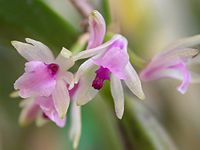Scaphyglottis
| Scaphyglottis | ||||||||||||||||||||
|---|---|---|---|---|---|---|---|---|---|---|---|---|---|---|---|---|---|---|---|---|
 Scaphyglottis stellata
| ||||||||||||||||||||
| Scientific classification | ||||||||||||||||||||
| ||||||||||||||||||||
| Type species | ||||||||||||||||||||
| Fernandezia graminifolia Ruiz & Pavón 1798 | ||||||||||||||||||||
| Species | ||||||||||||||||||||
| ||||||||||||||||||||
| Synonyms | ||||||||||||||||||||
|
Scaphyglottis is an orchid genus formed by almost seventy species characterized by the habit of shooting new pseudobulbs both from the apex and from the base of older ones. A great variety of different plant and flower morphologies which have been described as distinct genera through the years are today considered synonyms of Scaphyglottis. Many species are similar and hard to distinguish, while a few are easy to recognize. Scaphyglottis is a genus widespread throughout the tropical New World. Their flowers are usually small and pale dull colored, however, some species have bright red, purple or green flowers. As they usually bloom again, during several years, on the same pseudobulbs they become interesting plants to the orchid enthusiasts and are occasionally found in orchid collections.
Distribution
The sixty nine currently accepted Schaphyglottis species[1] are spread throughout wide area from South of Mexico to South of Bolivia an all Brazil except south region, from sea level to high altitudes on the Andes. They exist in several Caribbean islands, where, usually, are endemic species. The South of Central America, where most of the species occur, can be considered their center of distribution.[2]
Schaphyglottis are epiphytes, occasionally rupicolous, which often form large desorganized colonies, sometimes ascending or pending from the tree branches. They habit both warm and humid forests of low altitudes from the coastal areas and Amazon as, less frequently, dry jungles on the plateaus. Few species are occasionally found in cloud montane forests in the Andes and Costa Rica, then ordinarily in open sunny areas or on the top of the trees.[3]
Description
The size of Schaphyglottis plants is highly variable. There are delicate tiny species that barely surpass a few centimeters to large and robust ones also reaching one meter heigh. All species show elongated narrow pseudobulbs, on the base protected by several ephemeral sheaths which remain for long time after dried. The pseudobulbs grow both superposed from the apexes and occasionally from the bases of older pseudobulbs forming a long chain; they bear up to three apical leaves.[3] The leaves generally are thin and flat, narrow and elongated although some species have almost terete fleshy leaves.
The inflorescence shoots from the extremity of the pseudobulbs and, different from most orchids, which just bloom once each pseudobulb, Scaphyglottis blooms during several years from older ones. As the pseudobulbs are superposed giving the impression of a long stem, and the older ones bloom again the flowers appear to be along this stem and not on the apexes of each pseudobulb as they really are. The inflorescences may be panicles or racemes, bearing one, few or many, clustered or spaced flowers, which open simultaneously or in succession.
Their flowers are small, generally pale white, cream, green, pinkish, but pale, the exeption are the flowers of species that belonged to the genus Hexisea, mostly red;[3] the petals and sepals present similar lengths however the petals usually are wider and the labellum the largest floral structure, frequently with its apex reflected, the base attached to the salient column foot forming a chin, often articulated but sometimes fused to it. The anther is terminal and may contain four or six pollinias.
Scaphyglottis can be separated from its closest genera, among which Jacquiniella is the most noted, because the other genera present cauline pseudobulbs covered by alternating leaves and flowers of columns without a foot.[3]
Most of Scaphyglottis species are pollinated by short tongue insects because almost all produce nectar that accumulates in the mentioned chin. The species of red flowers possibly are also pollinated by hummingbirds, birds which have a preference for red flowers.[2]
- ↑ R. Govaerts, M.A. Campacci (Brazil, 2005), D. Holland Baptista (Brazil, 2005), P.Cribb (K, 2003), Alex George (K, 2003), K.Kreuz (2004, Europe), J.Wood (K, 2003, Europe) (accessed March 2009). World Checklist of Orchidaceae. The Board of Trustees of the Royal Botanic Gardens, Kew. [2=http://www.kew.org/wcsp Published on the Internet.]
- ↑ 2.0 2.1 Robert Dressler (2001) Scaphyglottis in Em A. M. Pridgeon, P. J. Cribb, M. W. Chase, and F. N. Rasmussen eds., Genera Orchidacearum vol. 4: 310-3. Oxford University Press, Oxford, UK ISBN 0198507127.
- ↑ 3.0 3.1 3.2 3.3 Hoehne, Frederico Carlos (1940). Orchidaceae - introduction in Flora Brasílica Vol. 12.1. São Paulo.